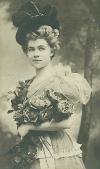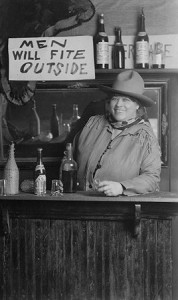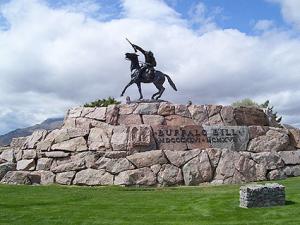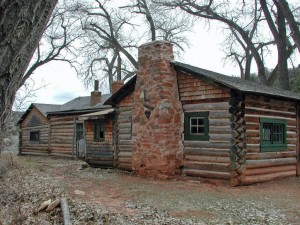Howdy, Folks!! It’s a beautiful day on the trail! We’re movin’ out of the darker side of Wyomin’s past…well… ‘cause frankly Cookie and me were gettin’ a might depressed. Cookie’s stew has never been particularly savory, but we were gettin’ sour stomach!
So today we’re visitin’ with one of Wyomin’s more colorful characters, Caroline Lockhart! I have to tell ya outta all the people we’ve met on the trail Ms. Lockhart is a favorite for Cookie and me! Now we’re particularly fit to be tied ‘cause Ms. Lockhart is Wyomin’s first woman author and a founder of the Cody Stampede! A woman who writes AND is involved with rodeo…Can I be her when I grow up?!
“Wyoming Girl’s First Novel is Successful…Equals Owen Wister in Thrilling Western Story!” (And no this isn’t about yours truly…yet) Announced the Cheyenne State Leader on March 11, 1911. “Not since the publication of The Virginian has so powerful a cowboy story been told as Miss Caroline Lockhart’s novel Me—Smith.”
Born in Illinois, Caroline Lockhart spent fifteen years as a newspaper reporter in the East. But in 1904, she turned her thoughts to writing a novel and her feet to the West she always admired. When she stepped off the train, the thirty-three year old cut a fine figure with gold-burnished hair that caught the sun and the eye of many a cowboy. What caught Caroline’s eye was the town of Cody, Wyoming and the diverse peoples of the West; sheepherders, cowboys, Indians and even dudes from the East. The town Caroline first laid eyes on had 210 inhabitants and 14 saloons, “none too many for such an arid landscape,” according to Caroline.
Though not well-known today, during the 1920s, Lockhart reached her goal of becoming “the best known woman west of the Mississippi.” Her novels The Fighting Shepherdess and The Man from the Bitter Roots had been made into major motion pictures, and she had recently finished a stint as a celebrity journalist at the Denver Post. The Park County Enterprise reported on her trip to Los Angeles. “Los Angeles, the mecca of artists and authors has a famous visitor this week in Caroline Lockhart who wrote The Fighting Shepherdess and other best sellers of the day. Miss Lockhart’s first visit upon her arrival was to the Louis B. Mayer studio.” There she met with Douglas Fairbanks regarding the adaptation of her nearly completed novel The Dude Wrangler.
Lockhart had a passion for the Old West; for the open-range cattle ranches before they were fenced and turned to dry-land farming, for the old characters who fought and scraped and survived the harsh land, and she loved, with a passion, horses. Her passions matched those of her contemporaries in Western novelists, such as Owen Wister and Zane Grey. But unlike other writers, Lockhart lived fulltime in the West. Therefore, her lifestyle brought authenticity to her work, not the depictions of what Easterners wanted the West to be. Also, Caroline set her stories during the 20th Century, unlike other authors who set their tales in the Old West. She wanted Wyoming to recognize its place in the present, and not fade into the past like the Midwestern frontier in the light and luxuries brought by the industrialization of the 20th Century. Wyoming’s heritage was dying on the altar of railroads, electricity, and automobiles. Who needed horses? Why would anyone care about the American Indians? Only a small tip of the hat should be given to men such as Buffalo Bill Cody, whose legendary status was diminished by divorce and financial ruin.
Lockhart’s novels breathed life back into Western culture. “Three cheers and a tiger for Caroline Lockhart. She is our only live, living author. What Caroline doesn’t know about Wyoming and Wyoming folks isn’t much. She can make a cavalier out of a sheepherder and a courtly gentleman from the crudest cowpuncher,” a Wyoming newspaper reported.
Almost 50 years old when her novels reached their peak, Lockhart appeared decades younger and “was one hell-of-a-good-lookin’ woman” according to one of her cowboy friends. And Caroline Lockhart had many cowboy friends. Although she never married, she juggled multiple boyfriends offending many of the more conservative citizens of Cody. Along with her long line of lovers, Codyites were fanning themselves over Lockhart’s penchant for drinking at a time three-quarters of the town voted for Prohibition. Lockhart, on the other hand, threw lavish parties in her Cody home where there was no lack of the demon liquor. In 1921, The State Tribune of Cheyenne published Lockhart’s letter to J.D. Woodruff in Shoshoni supporting his stand against Prohibition. “Mr. Woodruff: I have finished reading your letter to Governor Brooks printed in the Tribune, and I am impelled to write and congratulate you upon your common sense and courage. It sounds like Colonel Henry Watterson—a sane voice in the mob always. What you say finds an echo in the heart of every person who is not a hopeless bigot…”
Lockhart was, to say the least, a controversial figure, but she was a woman with “passion, gumption, and money to get things done.” One thing she wanted to see done was an event to honor the Old West. So, on April 20, 1920 the bestselling novelist with a flair for publicity, gathered with other leading citizens of Cody; Ernest J. Goppert, Sr., an ambitious young attorney; Irving H. Larom, a Princeton-education owner of a prominent dude ranch; Sid Eldred, editor of the Park County Enterprise, the newspaper founded by Buffalo Bill Cody; and Clarence Williams and William Loewar, both men helped run the town’s small Fourth of July celebration. All agreed they wanted more than just a Fourth of July party, more than a rodeo and street dance. They wanted an event to bring back the Old West; an event to entertain and bring in tourists driving through the newly opened road to Yellowstone National Park.
The citizens who met in Lockhart’s house, and enjoyed her liquor, decided they would call this event “The Cody Stampede.” Lockhart persuaded them not to include the word “rodeo” in the title as it “sounded like a dude word and besides we did not know how to pronounce it.” Lockhart was elected the organization’s president. They sought to attract the finest contestants, which included one of Lockhart’s cowboy friends, champion bulldogger Pinky Gist.
The week after the meeting, Lockhart purchased, with four partners, the Enterprise. She took control of the newspaper and used it to promote the Stampede. Her Enterprise advertised such exciting news as: Toggery Bill securing “the Red Lodge Finnish orchestra and the only Mary Quilico for the Cody Stampede.” And when Miles City, Montana chose the same dates for their rodeo, Lockhart and company stood firm believing “if necessary, there are enough riders and horses in the surrounding country to furnish a good program without outside help. Bronco riders and Grand Opera stars, we have learned from experience, have similar temperments [sic], and while some of the outside riders had their growl because they did not get in on the money we believe that a good percentage of them will come back and make another try for it.”
Lockhart was correct and many top riders returned to Cody. The Stampede grew under Lockhart’s presidency. At fundraising balls Caroline invited members of the Crow tribe to appear in traditional dress, renewing a fascination for the American Indians rarely seen in Cody except by invitation. With Lockhart’s encouragement, fascination expanded to other aspects of the frontier. Lockhart argued Wyoming should capitalize on its unique cowboy heritage, rather than letting the state develop into a place like anywhere else. Today the Stampede stands among the top rodeos with Cheyenne Frontier Days and the Pendleton (Oregon) Roundup.
Promoting Wyoming’s legacy became her passion. She next, proposed a gigantic statue of Buffalo Bill to be sculpted by Gertrude Vanderbilt Whitney, one of the country’s most famous artists. By then the people of Cody would support any suggestion their local author made, but the town could not afford Whitney. Lockhart proceeded to pester the sculptor until Whitney agreed to both sculpt the statue and raise the required funds. Whitney campaigned for funds amongst New York City’s wealthiest classes, establishing Buffalo Bill’s nationwide posthumous reputation.
After a few years, Lockhart tired of the day-to-day frustrations of the newspaper and guiding the Stampede. She believed local merchants never contributed all they could to an event that brought them so much business. She bristled at the incompetence of her co-owners at the newspaper, and her unpopular political positions made enemies and dampened profits.
In 1925, Caroline decided instead of promoting the Old West lifestyle she loved so much, she would embrace it and she purchased her own homestead. She purchased a small 160 acre homestead, the L/♥, north of Lovell, Wyoming. She added land through purchase, homesteading, and leases until she controlled over 6,034 acres. From the owners she inherited a two-room cabin, a few run-down sheds, and 20 acres of cultivated ground. Lockhart added onto and landscaped the area around the cabin with irises, hollyhocks, cottonwood trees, and stone pathways. She constructed fences, corrals, and irrigation systems as well as adding 15 new structures.
Life on the L/♥ ranch was self-sufficient. Potatoes, apples, onions, carrots, dried beans and peas, along with beef, pork, and wild game were stored in the powerhouse/storage building. Milk, butter, and eggs went to the spring house for chilling. In 1935, three loads of Lockhart steers topped the market in Omaha, granting Lockhart her dream of becoming a Cattle Queen.
In 1952, Caroline decided she and her then-boyfriend were too old to continue running the ranch. Her eyesight was failing and ranch life had become too hard. She moved back to Cody, and lived the rest of her life in obscurity. Her only foray into society was inviting neighborhood children over to watch “Hopalong Cassidy,” on the only television in town. A show based on novels that in 1910 were considered inferior to her works.
Caroline Lockhart died on July 25, 1962. There was no funeral as she had requested her ashes be scattered over “the most convenient peak.”
A woman who not only loved Wyoming and the West, but did all in her power to see its legacy preserved! I’m a bit ashamed to admit that as a writer and Wyomingite the first I heard of this amazing woman was when I was diggin’ around for blog material.
But Cookie and me made fast tracks to meet up with Ms. Lockhart on the trail, some cause of her enduring story and some cause after all our time on the dark side of the trail Cookie needed a couple fingers of whiskey and with Prohibition and all Caroline was the only one servin’ the stuff!
We hope y’all enjoyed readin’ about this lady as much as we enjoyed diggin’ through newspapers and articles to meet her. My mind’s already turnin’ and twistin’ about a heroine based on the woman.
See y’all on the bright side of the trail!
SOURCES:
Cheyenne State Leader, no 136. Cheyenne, Wyoming. March 11, 1911, page 5.
Wyoming State Tribune, no. 93. Cheyenne, Wyoming. April 14, 1921, page 1.
Park County Enterprise, no. 32. Cody, Wyoming. March 17, 1920, page 1.
Wyoming State Tribune, no. 169. Cheyenne, Wyoming. June 30, 1921 [Morning edition], page 6.
Park County Enterprise, no. 36. Cody, Wyoming. April 13, 1921, page 1.
http://www.jstor.org/discover/10.2307/4518949?uid=3739256&uid=2&uid=4&sid=21101129651861
http://www.nps.gov/bica/historyculture/caroline-lockhart-ranch.htm









Great post, I am sorry to say I have never heard of her either until today. Shame on us!!!!
I know, Quilt Lady, I was really surprised Caroline doesn’t get more notoriety especially with her roll in making the Stampede a success. But I was thrilled to stumble upon her story. So glad you enjoyed it, too.
–Kirsten Lynn